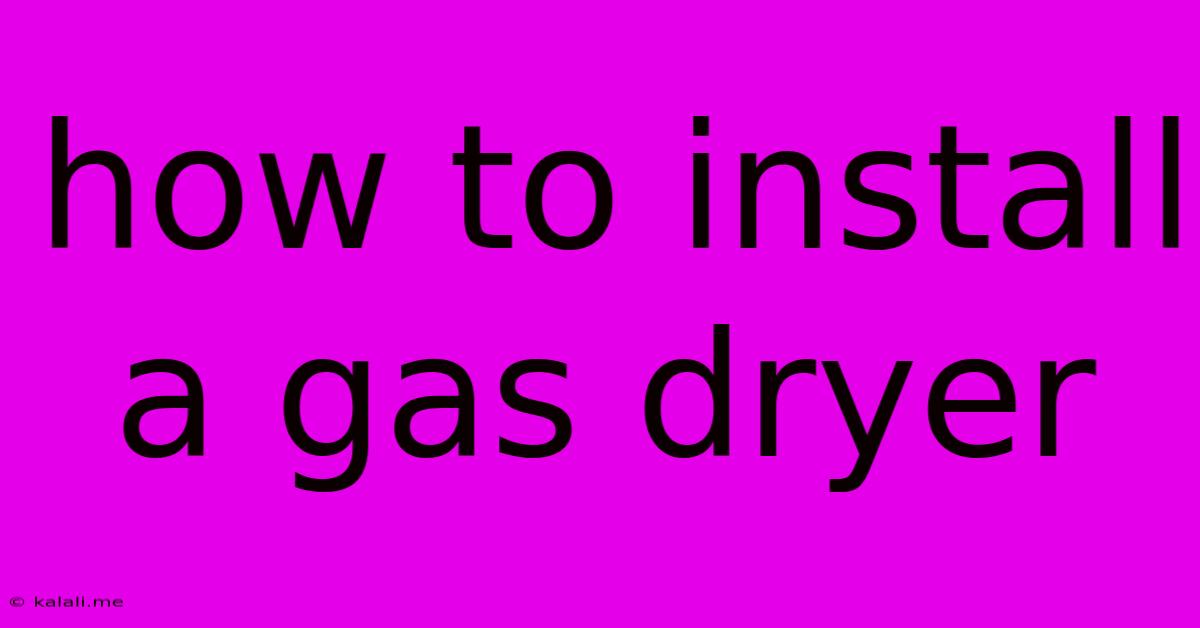How To Install A Gas Dryer
Kalali
Jun 02, 2025 · 4 min read

Table of Contents
How to Install a Gas Dryer: A Step-by-Step Guide
Meta Description: Learn how to safely and correctly install a gas dryer in your home. This comprehensive guide covers everything from checking gas lines to connecting the vent, ensuring your dryer is ready to use.
Installing a gas dryer might seem daunting, but with careful planning and the right tools, it's a manageable DIY project. This guide will walk you through each step, ensuring a safe and efficient installation. Remember, safety is paramount; if you're uncomfortable with any step, consult a qualified gas appliance technician.
1. Preparation is Key: Safety First!
Before you even begin unpacking your new dryer, prioritize safety. This includes:
- Turning off the gas supply: Locate your gas meter and turn off the main gas supply valve. This prevents accidental gas leaks during the installation process.
- Proper ventilation: Ensure adequate ventilation in the area where you're working. Gas leaks can be dangerous, so good airflow is crucial.
- Gathering your tools: You'll need a level, adjustable wrench, pipe wrench, gas line connector (if needed), gas leak detector (highly recommended), and a flexible gas connector hose designed for dryers. You’ll also need your dryer's installation manual for specific instructions.
- Checking local codes: Familiarize yourself with local building codes and regulations regarding gas appliance installation. These codes can vary by region.
2. Connecting the Gas Line
This step requires extra caution.
- Locate the gas shut-off valve: Your gas dryer should have a shut-off valve near its connection. Ensure it’s turned off.
- Inspect the existing gas line: The gas line should be in good condition, with no visible damage or leaks. If you’re unsure, call a gas professional.
- Connecting the flexible gas connector hose: Carefully attach the flexible gas connector hose to both the gas line and the dryer's gas inlet. Tighten the connections securely with the appropriate wrench, but avoid over-tightening.
- Checking for leaks: After connecting the hose, use a gas leak detector to meticulously check for any leaks around the connections. If you detect a leak, immediately turn off the gas supply and tighten the connections further. If the leak persists, call a qualified technician. Never use a match or lighter to check for gas leaks.
3. Positioning and Leveling Your Dryer
- Choose the right location: Select a level, stable surface for your dryer. Ensure there is enough space around the dryer for proper ventilation and access to the lint filter and controls.
- Leveling the dryer: Use the adjustable feet on the dryer to ensure it's perfectly level. An unlevel dryer can cause vibrations and potentially damage during operation.
- Securing the dryer: Once leveled, ensure the dryer is stable and won't easily move. Some dryers might require additional securing measures depending on the installation location.
4. Connecting the Vent
Proper venting is critical for safe and efficient dryer operation.
- Choosing the right vent: Use rigid metal ductwork whenever possible; flexible ductwork can restrict airflow and increase the risk of fire.
- Making the connection: Connect the dryer's vent to the vent ductwork securely. Use clamps or other fastening devices to create a tight seal. Keep the vent as short and straight as possible to prevent airflow restrictions.
- Preventing lint buildup: Ensure the vent is clear of any obstructions. Regularly clean the lint trap on the dryer and the vent itself to prevent lint buildup, which can be a fire hazard.
5. Electrical Connection
While this guide focuses on the gas connection, don't forget the electrical.
- Proper electrical circuit: Ensure you have a dedicated electrical circuit with the correct voltage and amperage for your dryer. Consult your dryer’s manual for specific requirements.
- Qualified electrician: If you’re not comfortable working with electricity, call a qualified electrician to handle this step.
6. Testing and Final Checks
Before starting your dryer, perform final checks:
- Gas leak check: Perform one last gas leak check using your leak detector.
- Vent check: Check that the vent is correctly connected and free of obstructions.
- Electrical connection check: Ensure all electrical connections are secure and correctly wired.
- First run: Run your dryer with a small load of laundry. Listen for any unusual noises or smells.
By following these steps carefully and prioritizing safety, you can successfully install your gas dryer. Remember that if you encounter any difficulties or are unsure about any aspect of the installation, contact a qualified gas appliance technician. They have the expertise and tools to ensure a safe and proper installation.
Latest Posts
Latest Posts
-
Your Configuration Specifies To Merge With The Ref
Jun 04, 2025
-
Why Does My Cat Have Extra Fur On Her Belly
Jun 04, 2025
-
Ac Low Side Pressure Too Low High Side Normal
Jun 04, 2025
-
Cayenne Pepper Vs Crushed Red Pepper
Jun 04, 2025
-
How Long Does It Take To Charge A Battery
Jun 04, 2025
Related Post
Thank you for visiting our website which covers about How To Install A Gas Dryer . We hope the information provided has been useful to you. Feel free to contact us if you have any questions or need further assistance. See you next time and don't miss to bookmark.